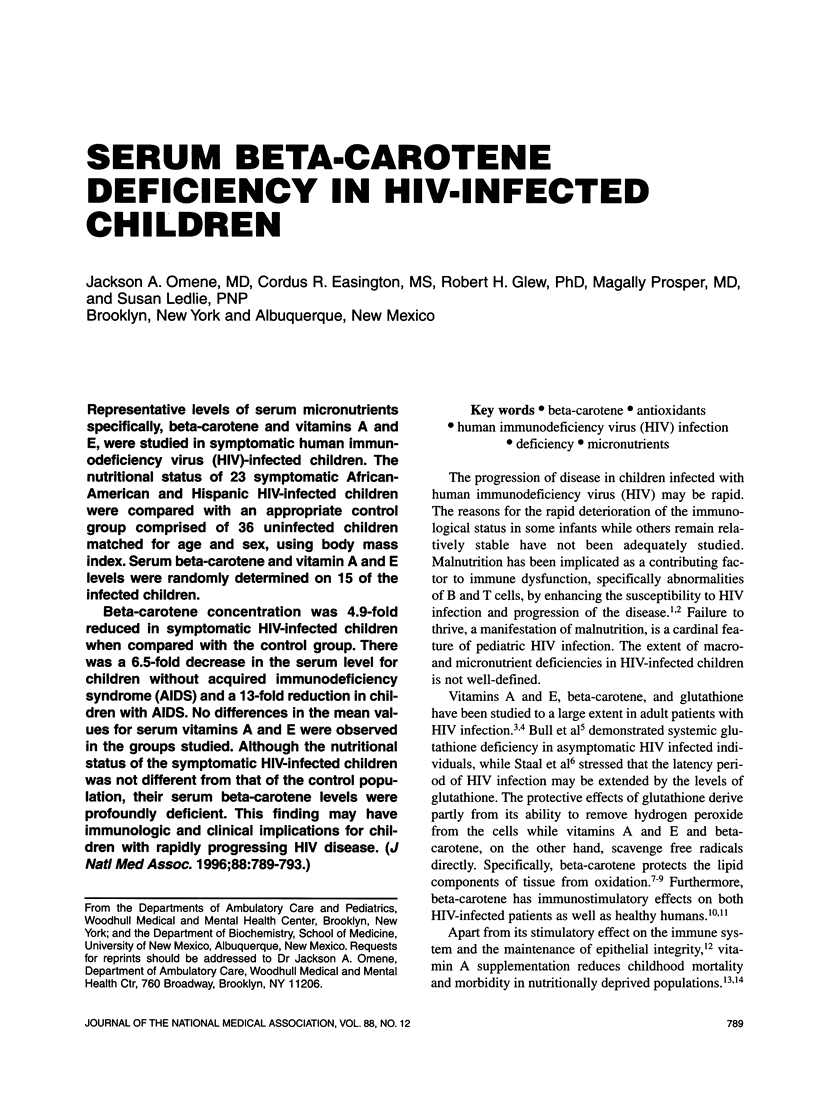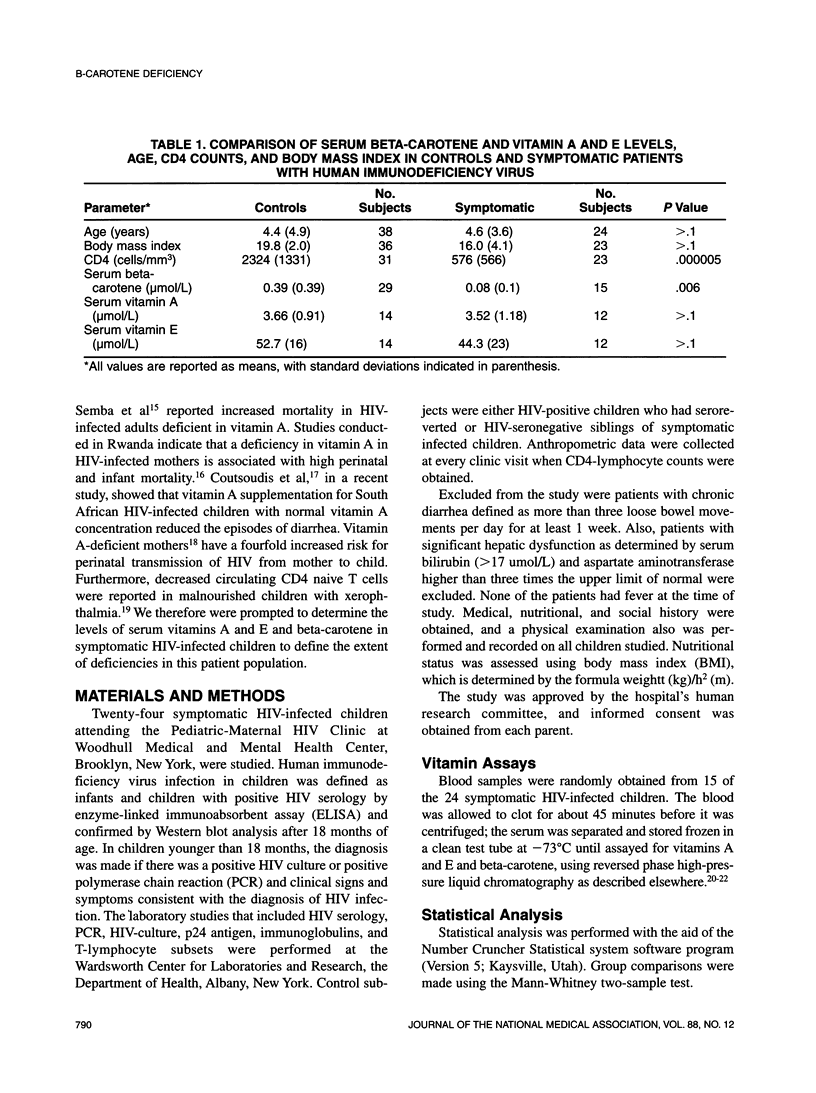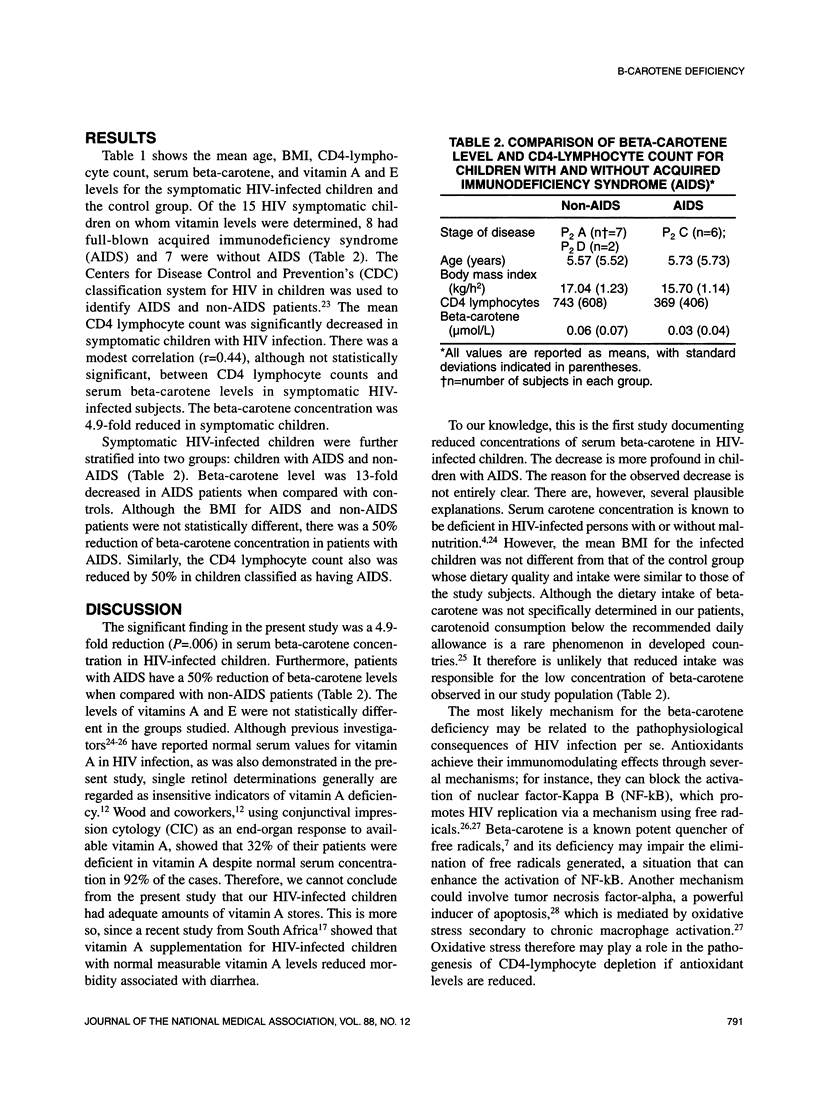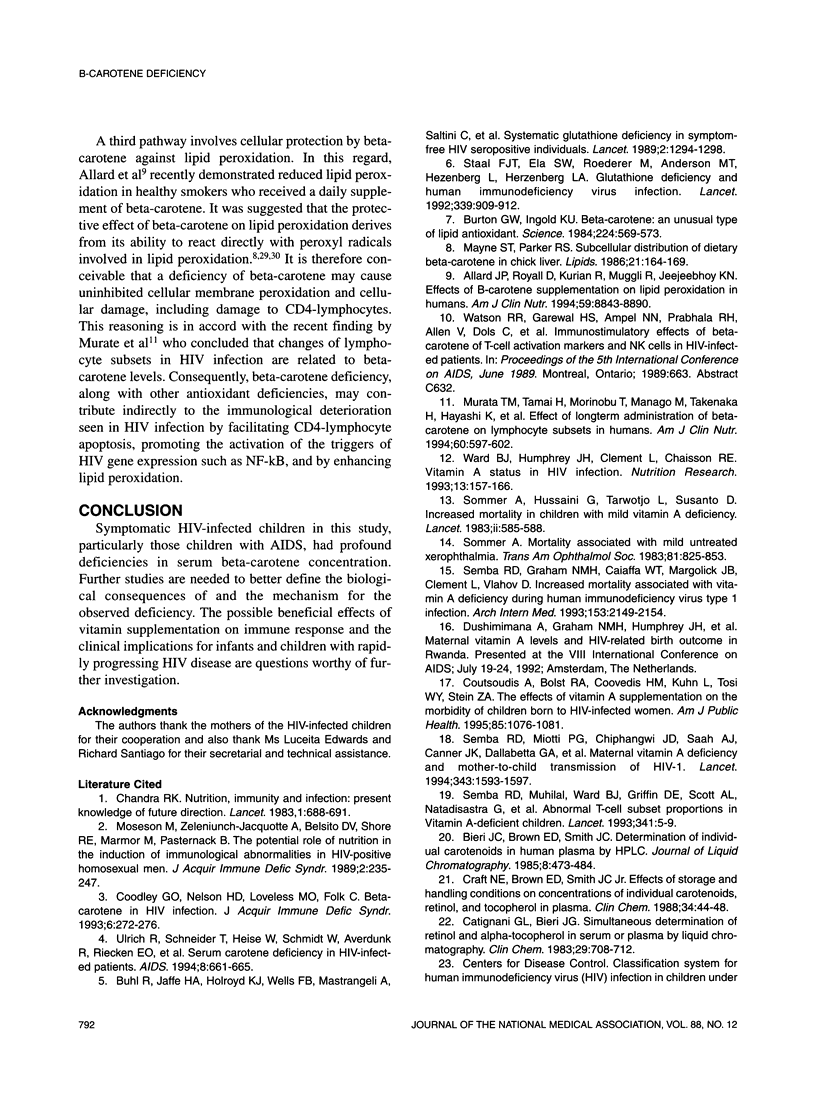Abstract
Representative levels of serum micronutrients specifically, beta-carotene and vitamins A and E, were studied in symptomatic human immunodeficiency virus (HIV)-infected children. The nutritional status of 23 symptomatic African-American and Hispanic HIV-infected children were compared with an appropriate control group comprised of 36 uninfected children matched for age and sex, using body mass index. Serum beta-carotene and vitamin A and E levels were randomly determined on 15 of the infected children. Beta-carotene concentration was 4.9-fold reduced in symptomatic HIV-infected children when compared with the control group. There was a 6.5-fold decrease in the serum level for children without acquired immunodeficiency syndrome (AIDS) and a 13-fold reduction in children with AIDS. No differences in the mean values for serum vitamins A and E were observed in the groups studied. Although the nutritional status of the symptomatic HIV-infected children was not different from that of the control population, their serum beta-carotene levels were profoundly deficient. This finding may have immunologic and clinical implications for children with rapidly progressing HIV disease.
Full text
PDF




Selected References
These references are in PubMed. This may not be the complete list of references from this article.
- Baruchel S., Wainberg M. A. The role of oxidative stress in disease progression in individuals infected by the human immunodeficiency virus. J Leukoc Biol. 1992 Jul;52(1):111–114. doi: 10.1002/jlb.52.1.111. [DOI] [PubMed] [Google Scholar]
- Bogden J. D., Baker H., Frank O., Perez G., Kemp F., Bruening K., Louria D. Micronutrient status and human immunodeficiency virus (HIV) infection. Ann N Y Acad Sci. 1990;587:189–195. doi: 10.1111/j.1749-6632.1990.tb00146.x. [DOI] [PubMed] [Google Scholar]
- Buhl R., Jaffe H. A., Holroyd K. J., Wells F. B., Mastrangeli A., Saltini C., Cantin A. M., Crystal R. G. Systemic glutathione deficiency in symptom-free HIV-seropositive individuals. Lancet. 1989 Dec 2;2(8675):1294–1298. doi: 10.1016/s0140-6736(89)91909-0. [DOI] [PubMed] [Google Scholar]
- Burton G. W., Ingold K. U. beta-Carotene: an unusual type of lipid antioxidant. Science. 1984 May 11;224(4649):569–573. doi: 10.1126/science.6710156. [DOI] [PubMed] [Google Scholar]
- Catignani G. L., Bieri J. G. Simultaneous determination of retinol and alpha-tocopherol in serum or plasma by liquid chromatography. Clin Chem. 1983 Apr;29(4):708–712. [PubMed] [Google Scholar]
- Chandra R. K. Nutrition, immunity, and infection: present knowledge and future directions. Lancet. 1983 Mar 26;1(8326 Pt 1):688–691. doi: 10.1016/s0140-6736(83)91980-3. [DOI] [PubMed] [Google Scholar]
- Coutsoudis A., Bobat R. A., Coovadia H. M., Kuhn L., Tsai W. Y., Stein Z. A. The effects of vitamin A supplementation on the morbidity of children born to HIV-infected women. Am J Public Health. 1995 Aug;85(8 Pt 1):1076–1081. doi: 10.2105/ajph.85.8_pt_1.1076. [DOI] [PMC free article] [PubMed] [Google Scholar]
- Craft N. E., Brown E. D., Smith J. C., Jr Effects of storage and handling conditions on concentrations of individual carotenoids, retinol, and tocopherol in plasma. Clin Chem. 1988 Jan;34(1):44–48. [PubMed] [Google Scholar]
- Krinsky N. I. Antioxidant functions of carotenoids. Free Radic Biol Med. 1989;7(6):617–635. doi: 10.1016/0891-5849(89)90143-3. [DOI] [PubMed] [Google Scholar]
- Larrick J. W., Wright S. C. Cytotoxic mechanism of tumor necrosis factor-alpha. FASEB J. 1990 Nov;4(14):3215–3223. doi: 10.1096/fasebj.4.14.2172061. [DOI] [PubMed] [Google Scholar]
- Mayne S. T., Parker R. S. Subcellular distribution of dietary beta-carotene in chick liver. Lipids. 1986 Feb;21(2):164–169. doi: 10.1007/BF02534440. [DOI] [PubMed] [Google Scholar]
- Moseson M., Zeleniuch-Jacquotte A., Belsito D. V., Shore R. E., Marmor M., Pasternack B. The potential role of nutritional factors in the induction of immunologic abnormalities in HIV-positive homosexual men. J Acquir Immune Defic Syndr. 1989;2(3):235–247. [PubMed] [Google Scholar]
- Rousseau E. J., Davison A. J., Dunn B. Protection by beta-carotene and related compounds against oxygen-mediated cytotoxicity and genotoxicity: implications for carcinogenesis and anticarcinogenesis. Free Radic Biol Med. 1992 Oct;13(4):407–433. doi: 10.1016/0891-5849(92)90183-h. [DOI] [PubMed] [Google Scholar]
- Schreck R., Rieber P., Baeuerle P. A. Reactive oxygen intermediates as apparently widely used messengers in the activation of the NF-kappa B transcription factor and HIV-1. EMBO J. 1991 Aug;10(8):2247–2258. doi: 10.1002/j.1460-2075.1991.tb07761.x. [DOI] [PMC free article] [PubMed] [Google Scholar]
- Semba R. D., Graham N. M., Caiaffa W. T., Margolick J. B., Clement L., Vlahov D. Increased mortality associated with vitamin A deficiency during human immunodeficiency virus type 1 infection. Arch Intern Med. 1993 Sep 27;153(18):2149–2154. [PubMed] [Google Scholar]
- Semba R. D., Miotti P. G., Chiphangwi J. D., Saah A. J., Canner J. K., Dallabetta G. A., Hoover D. R. Maternal vitamin A deficiency and mother-to-child transmission of HIV-1. Lancet. 1994 Jun 25;343(8913):1593–1597. doi: 10.1016/s0140-6736(94)93056-2. [DOI] [PubMed] [Google Scholar]
- Sommer A. Mortality associated with mild, untreated xerophthalmia. Trans Am Ophthalmol Soc. 1983;81:825–853. [PMC free article] [PubMed] [Google Scholar]
- Sommer A., Tarwotjo I., Hussaini G., Susanto D. Increased mortality in children with mild vitamin A deficiency. Lancet. 1983 Sep 10;2(8350):585–588. doi: 10.1016/s0140-6736(83)90677-3. [DOI] [PubMed] [Google Scholar]
- Ullrich R., Schneider T., Heise W., Schmidt W., Averdunk R., Riecken E. O., Zeitz M. Serum carotene deficiency in HIV-infected patients. Berlin Diarrhoea/Wasting Syndrome Study Group. AIDS. 1994 May;8(5):661–665. doi: 10.1097/00002030-199405000-00013. [DOI] [PubMed] [Google Scholar]


